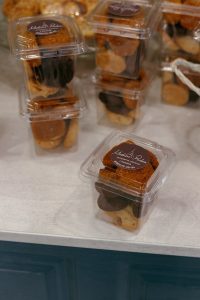Introduction
In the realm of culinary delights, sweet treats have always held a special place. Our journey today takes us back in time to explore the world of ancient desserts and sweets. While modern desserts often steal the spotlight, the past offers a treasure trove of confections waiting to be rediscovered. Join us on this delectable expedition into history, guided by the culinary wisdom of the renowned Julia Child.
About Our Guide: Julia Child
Before we embark on our adventure through the flavors of antiquity, let’s take a moment to introduce our guide, Julia Child. With her profound expertise in the culinary arts, Julia has long been a trusted source for all things food related. Her knowledge and passion for the culinary world make her the perfect companion for our exploration of ancient desserts.
Julia Child is celebrated for her extensive culinary career, including her groundbreaking cookbook “Mastering the Art of French Cooking.” Her culinary journey has taken her across the globe, and she has a knack for making the complex seem approachable, making her insights invaluable for our quest.
Honeyed Delights: The Oldest Sweetener
Our exploration begins with honey, one of the world’s oldest sweeteners. Ancient civilizations, from Egypt to Greece, revered honey for its natural sweetness and medicinal properties. Julia Child shares her insight into how honey was used to create delectable desserts, including honey cakes and pastries.

Exotic Ingredients: Spices, Nuts, and More
The allure of ancient desserts often lay in their use of exotic ingredients. Julia uncovers the spices, nuts, and fruits that added depth and flavor to these ancient confections. Discover the secrets of ingredients like saffron, almonds, and dates, which were cherished by civilizations for their taste and aroma.
From Mesopotamia to Rome: Ancient Desserts in History
Our historical journey takes us through the annals of time, exploring the desserts of Mesopotamia, Greece, and Rome. From the sweet doughnuts of the ancient Greeks to the decadent cakes of Roman banquets, we unveil the sweet traditions of these iconic civilizations.
Rediscovering Ancient Desserts: Modern Twists
While we cherish the past, we also appreciate the innovations of the present. In this section, Julia Child guides us through modern interpretations of ancient desserts. Learn how contemporary chefs and home cooks are reviving these age-old recipes, infusing them with new flavors and techniques while preserving their historical essence.
A Sweet Journey for Your Taste Buds
Our journey culminates in a celebration of flavor and history. Julia Child offers practical advice and tips for those eager to try their hand at creating these ancient sweets in their own kitchens. As we savor the past, we recognize the enduring appeal of ancient desserts and their power to transport us through time.

Conclusion
As we conclude our exploration of ancient desserts and sweets, we’re reminded that the culinary traditions of the past continue to inspire and delight us today. Julia Child’s expertise has illuminated the path, allowing us to savor the sweet treasures of antiquity with a newfound appreciation.
The next time you enjoy a honey cake or savor the aroma of saffron, you’ll have a deeper connection to the ancient artisans who first crafted these delectable treats. Let’s celebrate the enduring legacy of sweet indulgence and the joy of discovering history through flavor.
Table: Ancient Desserts Through the Ages
| Dessert Name | Origin | Key Ingredients | Unique Characteristics |
|---|---|---|---|
| Honey Cakes | Ancient Greece | Honey, Nuts, Spices | Sweetened with nature |
| Roman Pastries | Ancient Rome | Dates, Almonds, Cinnamon | Luxury and indulgence |
| Mesopotamian Doughnuts | Ancient Mesopotamia | Barley, Date Syrup | Early fried delights |










